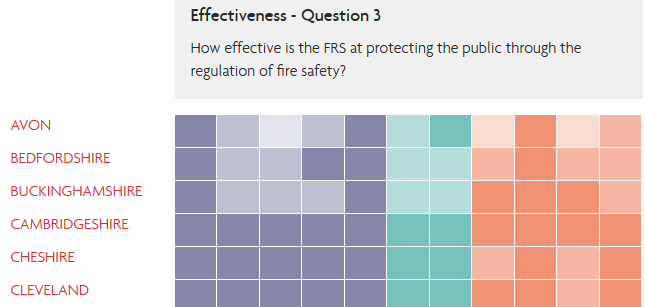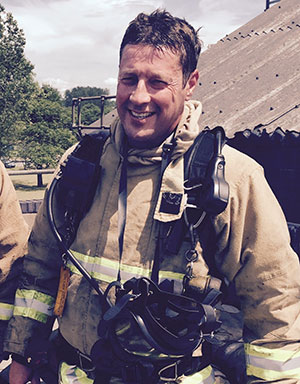For the next part of our study, we have looked at role of fire and rescue services in relation to the enforcement of the Fire Safety Order, and in particular, prosecutions.
The annual figures for prosecutions taken during the year ending March 2019 were published in October, but also of interest, are the results of audits and inspections carried out by her Majesty’s Inspectorate of Constabulary’s and Fire and Rescue Services (HMICFRS) which have now been completed and published for 2019. We have examined those findings, but only in relation to enforcement, and more specifically, the question “How effective is the FRS at protecting the public through the regulation of fire safety?”
| 1 | West Midlands | 133 |
| 2 | Greater Manchester | 80 |
| 3 | Lancashire | 69 |
| 4 | Greater London | 52 |
| 5 | North Yorkshire | 34 |
| 6 | Devon and Somerset | 33 |
| 7 | Cheshire | 32 |
| 8 | West Yorkshire | 27 |
| 9 | Avon | 23 |
| 10 | Surrey | 18 |
| 11 | Buckinghamshire | 16 |
| 12 | Cumbria | 14 |
| 13 | Derbyshire | 14 |
| 14 | East Sussex | 14 |
| 15 | Hampshire | 14 |
| 16 | Nottinghamshire | 13 |
| 17 | Oxfordshire | 13 |
| 18 | Merseyside | 13 |
| 19 | Tyne and Wear | 13 |
| 20 | Essex County | 12 |
Fire Services responsible for the most FSO prosecutions.
As can be seen from the table above, there is a wide disparity, even across the top 20 fire and rescue services when considering the number of prosecutions taken between 2006 and 2019. The national statistics, which began being recorded in March 2009, show that there were 669 prosecutions taken by English fire authorities over the 10 years until March 2019. In an attempt to complete the figures, by way of Freedom of Information requests, we asked all English fire and rescue services how may prosecutions they had taken between 1 October, 2006 (when the Order came into force) and March 2009. Only a handful of FRSs did not respond, and they tended to be the FRSs who had taken very few prosecutions. Our enquiries revealed that approximately 75 prosecutions were taken between those dates, making a total of 744 from 2006-2019.
Significantly, the 5 fire services responsible for the most prosecutions account for almost 50% of all cases taken across the country since the Fire Safety Order came into effect.
There may be a number of reasons for these Fire and Rescue Services bringing the most Prosecutions. The most obvious reason is that given their sheer size and the urban areas that they cover, there are naturally more premises, with potentially more breaches, resulting in more prosecutions.
However, the most likely reason for the difference in number of Prosecutions between Fire and Rescue Services is the issue of funding, and some smaller Fire and Rescue Services may argue that they do not receive the same level of state funding as the larger authorities and therefore they simply do not have the capacity/resources to carry out as many prosecutions.
Prosecutions are an expensive and time consuming process. A typical prosecution lasts approximately 12-18 months and the average costs orders (taken from our own 200 cases) is £5,661.00. Therefore, some Fire and Rescue Services may take the approach that they would prefer to pursue other polices in order to bring about compliance. There is no doubt that the austerity led budget cuts over the last 8 years have had a significant impact upon fire safety department.
Whether there are socio-economic or cultural reasons for non-compliance in particular areas is not clear. Such investigation would be highly sensitive and potentially divisive, but my experience is that cultural attitudes towards fire safety do impact upon prosecution rates in particular areas of the country, but I only have my own statistics to support this contention.
According to the government statistics there are 3 Fire and Rescue Services that have not carried out any prosecutions under the Fire Safety Order since its inception. The 20 authorities responsible for the lowest amount of prosecutions account for only 63 cases when combined. We have noted from our own cases, however, that there are irregularities and errors in the government statistics, and it may well be that these Services have indeed carried out a Prosecution but it has not been reported or factored into the government statistics.
Whether the audits and inspections carried out by HMICFRS will impact upon fire service policies or appetite for prosecutions remains to be seen. The most relevant question asked by inspectors in this regard was how effective the fire rescue service was at protecting the public through regulation of fire safety. This was one of the 5 questions asked to establish the effectiveness of FRSs at keeping people safe and secure from fire and other risks.
The inspectors considered 3 areas in this regard, i) the risk based approach; ii) enforcement – which involved training and the issuing of prohibition and enforcement notices as well as prosecutions; and iii) “working with others.”

Not surprisingly, the findings confirmed similar disparities in enforcement practice following inspections. 22 fire services were found to be “good”; 22 were found to “require improvement” and 3 were rated as “inadequate”. Not one fire service was found to be “outstanding” in this area.
Was there any correlation between the number of prosecutions taken and the inspector’s findings? Not really. Two of the top 5 authorities for taking prosecutions were found to “require improvement” and one of the authorities who had never taken a prosecution was found to be “good”. It is clear therefore that the taking of prosecutions is not the only key performance indicator when considering the protection of the public through regulation of fire safety.
There is no doubt that the press have already shown considerable interest in the findings of the inspections and there have already been management consequences in some authorities following publication of the inspection results.
Whether the public scrutiny of these findings and figures will impact upon policy decisions and appetites for prosecutions within fire and rescue services remains to be seen. Even Her Majesty’s Inspectors noted that the funding of fire safety departments clearly impacted upon their findings. If improvements are to be made extra funding will be required, even if the funding places fire safety departmentsin the same position as they were before budget cuts were made 7 or 8 years ago.
What is clear from the prosecution to statistics and from the HMICFRS findings is that the enforcement of the Fire Safety Order since 2006 has been, and is likely to remain, something of a postcode lotter
Link to Government statistics
Warren Spencer – Fire Safety Solicitor
James Aird – Fire Safety Lawyer
Link to HMICFRS



